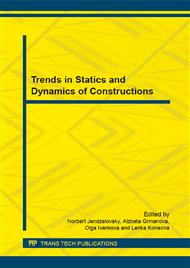[1]
C. C. Chamis, Simplified Composite Micromechanics Equations for Hygral, Thermal and Mechanical Properties, Houston, TX, 1-10, (1983).
Google Scholar
[2]
P. K. Kavipurapu, Forced Vibration and Hygrothermal Analysis of Composite Laminated Beams under the Action of Moving Loads, Morgantown, West Virginia, (2005).
DOI: 10.33915/etd.1601
Google Scholar
[3]
J. Sykora, M. Sejnoha, J. Sejnoha, Homogenization of coupled heat and moisture transport in masonry structures including interfaces, Applied Mathematics and Computation, 219 (13), 7275-7285, (2013).
DOI: 10.1016/j.amc.2011.02.050
Google Scholar
[4]
N. Jendzelovsky, Analysis of the 3D state of stress of a concrete beam, Advanced Materials Research, Volume 969, 45-50, (2014).
DOI: 10.4028/www.scientific.net/amr.969.45
Google Scholar
[5]
K. Tvrda, Probability and sensitivity analysis of plate, Applied Mechanics and Materials, Volume 617, 193-196, (2014).
Google Scholar
[6]
O. Sucharda, J. Brozovsky, Bearing capacity analysis of reinforced concrete beams, International Journal of Mechanics, Volume 7, Issue 3, 192-200, (2013).
Google Scholar
[7]
J. Kralik, Optimal design of NPP containment protection against fuel container drop, Advanced Materials Research, Volume 688, 213-221, (2013).
DOI: 10.4028/www.scientific.net/amr.688.213
Google Scholar
[8]
J. Melcer, G. Lajcakova, Comparison of finite element and classical computing models of reinforcement pavement, Advanced Materials Research, Volume 969, 85-88, (2014).
DOI: 10.4028/www.scientific.net/amr.969.85
Google Scholar
[9]
I. Oleksakova, O. Ivankova, Effect of the extension of basement floor and the importance of a proper design of interaction between the foundation and the subsoil, Advanced Materials Research, Volume 969, 148-154, (2014).
DOI: 10.4028/www.scientific.net/amr.969.148
Google Scholar
[10]
M. Krejsa, P. Janas, I. Yilmaz, M. Marschalko, T. Bouchal, The use of the direct optimized probabilistic calculation method in design of bolt reinforcement for underground and mining workings, The Scientific World Journal, Volume 2013, Article number 267593, (2013).
DOI: 10.1155/2013/267593
Google Scholar
[11]
M. Zmindak, Z. Pelagic, M. Bvoc, Analysis of high velocity impact on composite structures, Applied Mechanics and Materials, Volume 617, 104-109, (2014).
DOI: 10.4028/www.scientific.net/amm.617.104
Google Scholar


